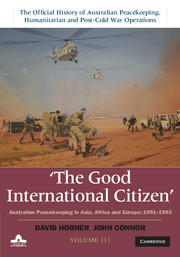Book contents
- Frontmatter
- Contents
- Maps
- Preface
- Chronology 1989–99
- Abbreviations
- Part 1 Strategy and policy
- Part 2 Cambodia
- 3 From Angkor Wat to Pol Pot
- 4 Law and order on the border
- 5 An Australian peace proposal
- 6 First into Phnom Penh
- 7 The roadblock
- 8 Change in plan
- 9 ‘Democracy's surprise triumph’
- 10 Developing Operation Banner
- 11 Winding up Operation Banner
- Part 3 Western Sahara
- Part 4 Former Yugoslavia
- Part 5 Watch on Iraq
- Appendix A United Nations Security Council resolutions
- Appendix B Major office bearers, 1991–99
- Bibliography
- Index
- Plate section
- References
4 - Law and order on the border
The Australian Federal Police and the UN Border Relief Organisation, 1989–93
from Part 2 - Cambodia
Published online by Cambridge University Press: 12 May 2022
- Frontmatter
- Contents
- Maps
- Preface
- Chronology 1989–99
- Abbreviations
- Part 1 Strategy and policy
- Part 2 Cambodia
- 3 From Angkor Wat to Pol Pot
- 4 Law and order on the border
- 5 An Australian peace proposal
- 6 First into Phnom Penh
- 7 The roadblock
- 8 Change in plan
- 9 ‘Democracy's surprise triumph’
- 10 Developing Operation Banner
- 11 Winding up Operation Banner
- Part 3 Western Sahara
- Part 4 Former Yugoslavia
- Part 5 Watch on Iraq
- Appendix A United Nations Security Council resolutions
- Appendix B Major office bearers, 1991–99
- Bibliography
- Index
- Plate section
- References
Summary
The land mine exploded as the elderly Cambodian man pushed his rickety water-cart – a 44-gallon drum mounted on two bicycle wheels – along a hot, dusty road in the Thai border camp known as Site 2. The blast tore a large hole in the ground and destroyed the cart. Miraculously, as the dust cloud settled, the old man materialised, stiff with shock but still standing, his hand gripped to the cart handle, deafened by the explosion, but otherwise unharmed. Barry Carpenter, an Australian Federal Police (AFP) superintendent, was at the Site 2 police headquarters when he heard the boom and quickly made his way towards it. The camp was awash with weapons and crammed with people willing to use them. This was why Carpenter and a team of international police officers had been sent to the border camps to establish a legal system and train a police force. In this case, the anti-personnel mine had actually been laid by one of the camp policemen after he had been dismissed for falsifying documents. Looking for revenge, he had placed the device near the home of a senior police officer. When Carpenter arrived at the scene of the explosion, the man, who still had not moved, had been surrounded – at a discreet distance – by a circle of spectators. The Australian police officer warily went forward and carefully moved along the cart's wheel tracks towards the man. When he reached the old man, Carpenter then cautiously retraced his steps, half guiding, half carrying the man to safety. A second land mine was afterwards found in the road. If Carpenter or the old man had stepped on it, then both would almost certainly have been killed.
- Type
- Chapter
- Information
- The Good International CitizenAustralian Peacekeeping in Asia, Africa and Europe 1991–1993, pp. 66 - 77Publisher: Cambridge University PressPrint publication year: 2014

